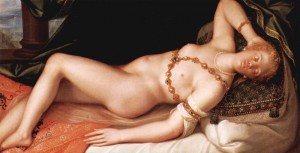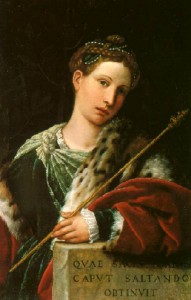- by Joseph Heintz the Elder
- Tullia d’Aragona, as Salome L’Erodiade by Moretto da Brescia
Tullia d’Aragona (c.1510-1556) was an Italian courtesan, author, and philosopher in Venice. Under her mother’s influence, Tullia had been initiated into the life of a courtesan when very young. She left us three books — her lyric Rime, her philosophical Dialogo, and her epic Il Meschino, and some urban legends. As an author and a literary character, she seems to court attention still. D’Aragona’s intellect and wit are evident in her Dialogue and in her dialogic poetry: in addition to poems by Tullia, illustrious men of letters wrote sonnets to her. Girolamo Muzio praises her intellectual beauty in the Dialogue’s preface and in poetry. The inspiration was mutual, and his love lasted until her death.
Misnamed “the intellectual courtesan,” Tullia d’Aragona transcended the destiny bequeathed by the unfortunate early death of Cardinal Luigi d’Aragona. Allegedly her father, the Cardinal paid for young Tullia to be tutored in the rudiments of a classical education as well as her training in poetry, music, and dance. When he died, her courtesan mother fashioned a “career” — from which she later escaped. Later in Florence, under the patronage of Cosimo de’Medici and his Spanish wife Eleonora di Toledo, Tullia was freed of the yellow veil that courtesans were required to wear as a sign.
Garnering fame, esteem, and freedom from the label of “courtesan,” the Rime established her as a talented Petrarchan poet. The Dialogue on the Infinity of Love satirizes and revises the Florentine Academy’s version of Neoplatonism. “Tullia’s” idea of honest love integrates body and soul, age and beauty, and both sexes in a treatise that is presciently feminist, giving women a symbolic place at the table.
Her romanzo Il Meschino (The Unfortunate One) narrates the picaresque travel adventures of its hero trying to find the parents from whom he was separated at birth. Unaware of his noble birthright, Meschino must get by on the basis of his merits — much like his author, who could not fully exploit her (illegitimate) birth into the royal family of Aragón, the rulers of Spain and southern Italy.
In 1547 the Venetian printer Giolito published Le Rime della Signora Tullia di Aragona et di diversi a lei (now Tullia d’Aragona’s Poetry of Dialogue) and Il Dialogo della Signora Tullia d’Aragona della Infinita di Amore (“Dialogue on the Infinity of Love”). Scholars also attribute to her the epic Il Meschino altramente detto il Guerrino (The Little Unfortunate One, a.k.a. the Little Warrior), (Venice: Sessa, 1560).
We can surmise that the young Penelope, who is said to be Tullia’s sister despite a 20-25 year age difference, was her daughter. We believe that Tullia tried not to make the same mistakes with Penelope that Tullia’s mother had made with her, although Penelope’s early death at age 13 prevents us from knowing much about her life. We do now have a statement that Tullia wrote in the preface to her epic, expressing regret that she had had such an early knowledge of the world. In addition to Penelope, Tullia d’Aragona had a son, Celio, who is mentioned in her will. She died in the Trastevere section of Rome in 1556, but not before finishing her epic Il Meschino.
Bibliography
Allaire, G. ‘Tullia D’Aragona’s Il Meschino as Key to a Reappraisal of Her Work.’ In Quaderni d’Italianistica. 16, no. 1, 1995, 33-50.
Aragona, Tullia d’. Dialogue on the Infinity of Love. Translated and edited by Rinaldina Russell and Bruce Merry. Chicago and London: University of Chicago Press, 1997.
—Il Dialogo della Signora Tullia d’Aragona della infinità di amore. Venice: Giolito, 1547.
— Il Meschino, altramente detto il Guerrino. Venice, G. B. & Melchior Sessa, 1560.
Basile, D. ‘ “Fasseli gratia per poetessa”: Duke Cosimo I de’Medici’s Role in the Florentine Literary Circle of Tullia d’Aragona,’ in The cultural politics of Duke Cosimo I de’Medici, edited by Konrad Eisenbichler, 135-148. Aldershot, UK; Burlington, VT.: Ashgate, 2001.
Benson, Pamela and Victoria Kirkham. Strong Voices, Weak History: Early Women Writers & Canons in England, France & Italy. Ann Arbor: University of Michigan, 2005.
Biagi, Guido. ‘Un’etèra romana. Tullia d’Aragona’, in Nuova antologia series III, 4, no. 16 (1886): 655-711.
Bongi, Salvatore. Annali di Gabriel Giolito de’Ferrari. Rome: presso i principali librai, 1890.
–‘Documenti senesi su Tullia d’Aragona’, in Rivista critica della letteratura italiana IV, no. 6 (1887): 86-88.
Celani, Enrico. Rime della Tullia d’Aragona, cortigiana del secolo XVI. Bologna, Romagnoli Dall’Acqua, 1891.
Cox, Virginia. Women’s writing in Italy, 1400-1650. Baltimore: Johns Hopkins University Press, 2008.
Croce, Benedetto. Poeti e Scrittori del Pieno e Tardo Rinascimento. Bari : G. Laterza, 1952-1958.
Croix, Jean François de la. Dictionnaire historique portative des femmes célèbres, 3 vols. Paris, 1769.
Domenichi, Ludovico. Rime diverse d’alcune nobilissime e virtuosissime donne. Venice, 1559.
Enciclopedia Italiana di Scienze, Lettere, & Arti, vol. XII, Istituto del Enciclopedia Italiana, 375. Rome, 1949.
Encyclopedia of Women in the Renaissance. Eds. Diana Robin, Anne R. Larsen and Carole Levin. Santa Barbara: ABC-CLIO, 2007. 26-30.
Gleichen-Russwurm, Alexander. The World’s Lure: Fair Women, Their Loves, Their Power, Their Fates. New York, London, A.A. Knopf, 1927.
Hairston, Julia L. and Walter Stephens. The Body in Early Modern Italy. Baltimore: Johns Hopkins University Press, 2010.
— ‘Out of the Archive’: Four Newly-Identified Figures in Tullia d’Aragona’s Rime della Signora Tullia di Aragona et di diversi a lei (1547).’ InMLN 118 (2003): 257-63.
–“Tullia d’Aragona.” Biography for the Chicago Italian Women Writers Project http://www.lib.uchicago.edu/efts/IWW/BIOS/A0004.html, 2005.
–‘Tullia d’Aragona’, in Encyclopedia of Women of the Renaissance; Italy, France, and England. A. R. Larsen, C. Levin, and D. Robin, 29. Santa Barbara, CA: ABC-CLIO, 2007, 26-30.
–“Tullia d’Aragona: Two New Sonnets,” P. Renée Baernstein and Julia L. Hairston, MLN 123 (2008): 151-59.
Hays, Mary. Female Biography; or Memoirs of Illustrious and Celebrated Women of all Ages and Countries (6 volumes). London: R. Phillips, 1803.
Jaffe, Irma B. and Gernando Colombardo. Shining Eyes, Cruel Fortune: The Lives and Loves of Italian Renaissance Women Poets. New York: Fordham University Press, 2002.
Jones, A. R. The Currency of Eros: Women’s Love Lyric in Europe, 1540-1620, 79-117. Bloomington: Indiana University Press, 1990.
–‘Bad Press: Modern Editors versus Early Modern Women Poets (Tullia d’Aragona, Gaspara Stampa, Veronica Franco).’ In Strong voices, weak history: early women writers and canons in England, France, and Italy, edited by Pamela Joseph Benson & Victoria Kirkham, 287-314. Ann Arbor: University of Michigan Press, 2005.
Jones, Ann Rosalind. The Currency of Eros: Women’s Love Lyric in Europe, 1540-1620. Bloomington: Indiana University Press, 1990.
Larivaille, Paul. La vie quotidienne des courtisans. Paris: Hachette, 1978.
Lochman, Daniel T., Maritere López and Lorna Hutson. Discourses and Representations of Friendship in Early Modern Europe, 1500-1700. Farnham, Surrey; Burlington, VT: Ashgate, ©2011.
Masson, Georgina. Courtesans of the Italian Renaissance, 89. New York: St. Martin’s 1975.
Mayne, Ethel Colburn. Enchanters of Men. New York, London, G.P. Putnam’s Sons, 1925.
Migiel, Marilyn and Juliana Schiesari. Refiguring Woman: Perspectives on Gender and the Italian Renaissance. Ithaca, N.Y.: Cornell University Press, 1991.
Pallitto, Elizabeth. A. Sweet Fire: Tullia d’Aragona’s Poetry of Dialogue and Selected Prose. New York: George Braziller, 2007.
— ‘Laura’s Laurels: Re-Visioning Platonism and Petrarchism in the Philosophy and Poetry of Tullia d’Aragona’. PhD dissertation, Graduate Center, City University of New York, 2002.
—“Muse to ‘Maestra’ and Pupil: Images of Tullia and Penelope d’Aragona in Muzio’s Eclogues,” Elizabeth A. Pallitto, Journal of Italian Translation, Vol. VIII, No. 1, Spring 2013, 214-233.
— “Tullia of Aragon.” Mary Hays, Female Biography; or, Memoirs of Illustrious and Celebrated Women, of All Ages and Countries, 1803. Chawton House Library Series: Women’s Memoirs, ed. Gina Luria Walker, Memoirs of Women Writers Part II. Pickering & Chatto: London, 2013, vol. 5, 312-14, editorial notes, 458.
Robin, D. Publishing Women: Salons, the Presses, and the Counter-Reformation in Sixteenth-Century Italy. Chicago and London: University of Chicago Press, 2008.
Russell, Rinaldina (ed.). The Feminist Encyclopedia of Italian Literature, 254-6. Westport, CT: Greenwood Press, 1997.
Servadio, Gaia. Renaissance Woman. London [etc.]: I. B. Tauris, 2005.
Schulman, Carol Leotta Moore. Lost & Found: Rediscovering Women Poets of the Italian Renaissance. Philadelphia, PA: Laughing Contessa Press, 2006.
Smarr, Janet Levarie and Daria Valentini. Italian Women and the City: Essays. Madison: Fairleigh Dickinson University Press, 2003.
—Joining the Conversation: Dialogues by Renaissance Women. Ann Arbor: University of Michigan Press, 2005.
Stortoni, Laura Anna and Mary Prentice Lillie. Women Poets of the Italian Renaissance: Courtly Ladies and Courtesans. New York: Italica Press, 1997.
Toffanin, G. Storia letteraria d’Italia, edited by Franco Flamini, 130. Milan: Casa Editrice, 1898-1902.
Wilson Katharina. An Encyclopedia of Continental Women Writers, 48-9. New York: Garland, 1991.
Zanrè, Domenico. Cultural non-conformity in early modern Florence. Aldershot, UK; Burlington, VT: Ashgate, 2004.
Resources:
Brooklyn Museum Elizabeth A. Sackler Center for Feminist Art: The Dinner Party:
Heritage Floor: Tullia d’Aragona
http://www.brooklynmuseum.org/eascfa/dinner_party/heritage_floor/tullia_d_aragona.php
Page citation:
Pallitto, Elizabeth A. “Tullia d’Aragona.” Project Continua (2014):
[date accessed], http://www.projectcontinua.org/tullia-d-aragona


